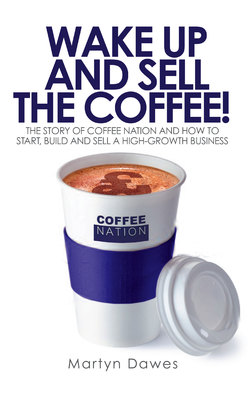Читать книгу Wake Up and Sell the Coffee! - Martyn Dawes - Страница 11
На сайте Литреса книга снята с продажи.
Early business planning
ОглавлениеMy planning continued. I met with the National Federation of Retail Newsagents and the Association of Convenience Stores. All saw the need for my business and welcomed anything that helped the small retailer. I lined up Dynorod (a franchise-based, nationwide plumbing company) to install mains water into each location. They provided me with detailed costs and I decided that I would pass this on as a set-up cost to the retailer. This was all they would pay up front.
The coffee machines would require maintenance. This was simple and would take less than an hour a week, so I decided that the staff in the shop could and should do this. An early – and accurate – realisation was that getting the retailer to play their part in the enterprise, i.e. by cleaning the machines, would be critical to success. For technical maintenance of the machines I met with a company called Neopost who maintained franking machines and were keen to diversify.
I thought long and hard about undertaking formal market research and had a number of proposals for face-to-face street interviews with consumers outside of newsagents and other potential locations. With my limited funds though, to blow £5k on a market study seemed like a big chunk to spend. I also questioned what market research could really tell me. My concern was that until the product was there, available to buy, all consumers could tell me was what they might do. This was not factual research.
So I abandoned this plan and instead spent a fraction of £5000 with a company called Verdict Research, asking them to look at each channel to market (e.g. CTNs, dry cleaners, doctor’s surgeries, estate agent’s offices, etc.). How many locations did they see per channel and what was the best way to target them?
With the thinking really taking shape I started to put together a business plan and worked out that each machine needed to sell a minimum of 100 cups per week. A typical newsagent was open for around 80 hours per week so 100 cups sold would mean 1.25 per hour. Surely this was realistic?
My plan dictated 190 machines installed across 1997. On that basis the business would turn profitable by the end of the year and with 500 machines by the end of 1998 it would achieve sales of around £1.5m and make 7% net profit.
What to name the business didn’t seem that important, particularly as we were using Nescafé as the public face and brand to the consumer. But a name was needed. A few mates congregated in our front room for the purposes of a brainstorming session. Trudi agreed to do supper, I supplied a few bottles of wine and we were off. Someone came up with West 1 Coffee (this sounded too much like a courier company) and Power Coffee (for bodybuilders?). Trudi’s leftfield response was Climax Coffee; after a few bottles of wine we loved this. In reality though… coffee that makes you orgasm? Not sure about that one.
I reminded those assembled that this was really about making coffee-to-go part of everyday life across the nation. I’m not sure who finally suggested Coffee Nation but it stuck and epitomised what we were about. Within weeks I had a logo to boot; a cheerful coffee pot going around the world in a smart blue and yellow colour scheme.
